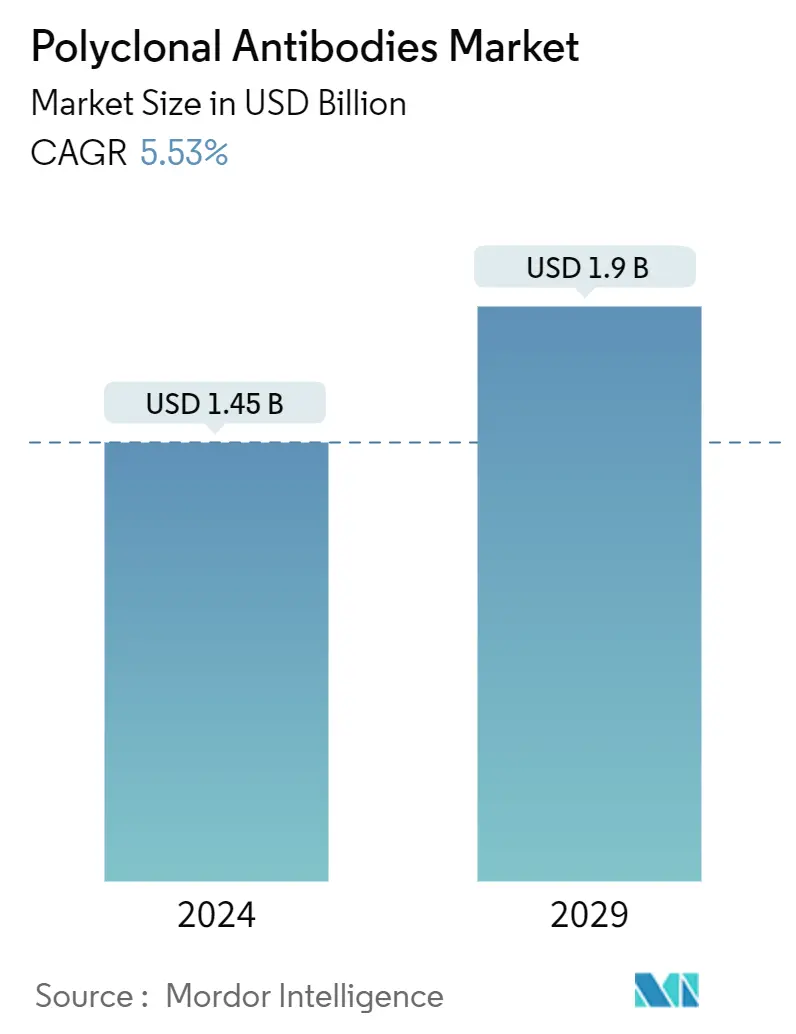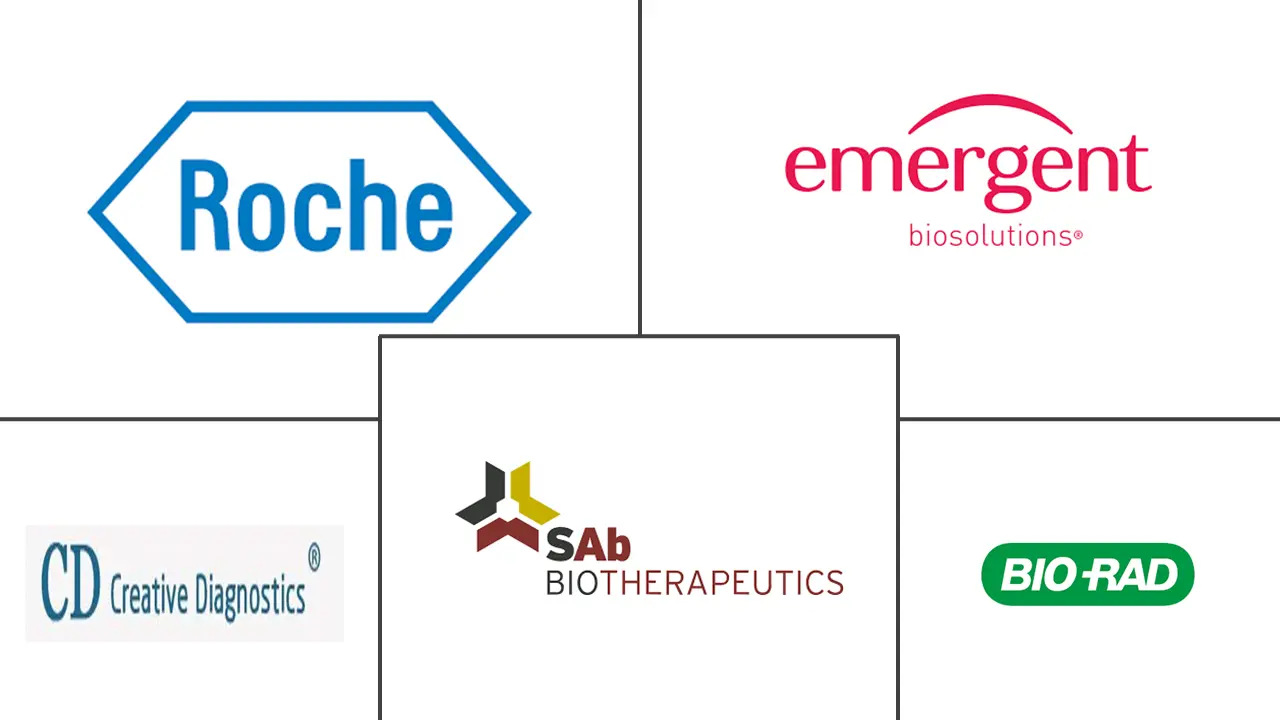Market Size of Polyclonal Antibodies Industry

| Study Period | 2018-2029 |
| Market Size (2024) | USD 1.45 Billion |
| Market Size (2029) | USD 1.9 Billion |
| CAGR (2024 - 2029) | 5.53 % |
| Fastest Growing Market | Asia Pacific |
| Largest Market | North America |
| Market Concentration | Medium |
Major Players
*Disclaimer: Major Players sorted in no particular order |
Polyclonal Antibodies Market Analysis
The Polyclonal Antibodies Market size is estimated at USD 1.45 billion in 2024, and is expected to reach USD 1.9 billion by 2029, growing at a CAGR of 5.53% during the forecast period (2024-2029).
COVID-19 significantly impacted the polyclonal antibodies market because it possessed a mutation that prevented antibody therapeutics from maintaining antiviral bindings and neutralizing efficacy. For instance, in March 2020, GigaGen, a US-based biotechnology company, developed a treatment called rCIG (recombinant anti-coronavirus 19 hyperimmune gammaglobulin). These polyclonal antibodies could be utilized to develop antibody therapeutics against future COVID-19 threats. According to the journal published by the National Library of Medicine in September 2023, during COVID-19, hundreds of antibodies were developed at preclinical and clinical stages in the format of polyclonal antibodies. Also, because of their potential to bind multiple targets and maintain their neutralizing activity despite mutations, these polyclonal antibodies have shown from animal origin to represent a promising approach. For instance, researchers developed XAV-19, a polyclonal antibody targeting COVID-19 that accelerated the recovery of mild to moderate COVID-19 patients. Thus, COVID-19 had a positive impact on the polyclonal antibodies market, and it was projected to witness lucrative growth in coming years owing to the development of new products and its pivotal role in treating noncurable diseases.
Further, infectious and chronic diseases can be considered as one of the biggest threats to humanity. There are many infectious diseases like Monkey Pox, Ebola, and Zika Virus and others. Antibodies and peptides are key to diagnosing and treating infectious diseases. According to a February 2022, Frontiers article, states that nontyphoidal Salmonella is a common cause of human bacterial enteritis. It causes approximately 93.8 million cases of gastroenteritis worldwide each year. Passive immunization with polyclonal hyperimmune globulin therapy is a proven strategy for delivering immunity. For instance, in May 2023, SAB Biotherapeutics, a biopharmaceutical company, announced the first publication of data for SAB-183 against Pneumonic Plague. It represented that the polyclonal antibodies derived from the transchromosomic bovine vaccinated with the recombinant vaccine increase bacterial opsonization in vitro and protect mice from the plague.
Moreover, chronic diseases like Cancer, Heart Disease, Stroke, Diabetes, Obesity, and many more are increasing globally. According to the article published by the World Health Organization in September 2023, 41 million people die from chronic diseases each year, which is equivalent to 74% of annual deaths. For instance, in the year May 2023, XENOTHERA, a clinical-stage biotechnology company, presented an abstract on its new product, XON7, which targets solid tumor cancer. It has shown promising effects on patients with the new line of treatments for several cancers.
Additionally, polyclonal antibodies are used in various diagnostic kits. It captures and detects antigens in patient samples in enzyme-linked immunosorbent assays. According to the article published by the National Library of Medicine in June 2022, these polyclonal antibodies are more accessible for developing and applying for fast and routine diagnostics in phytopathology and agricultural practice by Western immunoblotting assays. These polyclonal antibodies allow the binding of numerous antigenic determinants of the target, which results in better sensitivity in assays and leads to excellent stability. The biopharmaceutical industries have set up high standards for product efficacy, safety, and quality. For instance in April 2023, SAB Biotherapeutic recently announced positive results from phase 3 clinical trials of SAB-185 in patients with COVID-19 at high risk for severe complications.
However, limited availability of high-quality polyclonal antibodies as multiple cell clones generate polyclonal antibodies, and the resulting antibodies can vary in their affinity and specificity for the antigen. This factor can cause a hurdle in the growth of the polyclonal antibodies market.
Polyclonal Antibodies Industry Segmentation
As per the scope of the report, the polyclonal antibody market comprises a group of antibodies that represent the body's normal immunological response to an antigen. These are a collection of immunoglobulin molecules that react to a certain antigen and isolate different epitopes from that antigen. The polyclonal antibody market is segmented by product type (primary antibody and secondary antibody), source type( rabbit, mouse, goat, horse, and other animals), application (diagnostic and clinical research), end-user (hospitals, academics, biopharmaceutical industries, biotechnology industries, and diagnostic centers), and geography (North America, Europe, Asia-Pacific, Middle East and Africa, and South America). The report also covers the estimated market sizes and trends for 17 countries across major regions globally.
The report offers the value (in USD) for the above segments.
| By Product Type | |
| Primary Antibody | |
| Secondary Antibody |
| By Source | |
| Rabbit | |
| Mouse | |
| Goat | |
| Horse | |
| Other Animals |
| By Application | |
| Diagnostic | |
| Clinical Research |
| By End User | |
| Hospitals | |
| Academic and Research Centers | |
| Bio-Pharmacuetical Industries | |
| Biotechnology Companies | |
| Diagnostics Centers |
| Geography | ||||||||
| ||||||||
| ||||||||
| ||||||||
| ||||||||
|
Polyclonal Antibodies Market Size Summary
The polyclonal antibodies market is poised for significant growth, driven by their versatile applications in diagnosing and treating infectious and chronic diseases. The market has been positively influenced by the COVID-19 pandemic, which spurred the development of polyclonal antibody therapeutics, showcasing their ability to bind multiple targets and maintain efficacy despite viral mutations. This has led to increased interest and investment in polyclonal antibodies as a promising approach for treating noncurable diseases. The market is also benefiting from advancements in biopharmaceutical research, with companies like SAB Biotherapeutics and XENOTHERA making strides in developing treatments for diseases such as pneumonic plague and cancer. Additionally, the use of polyclonal antibodies in diagnostic kits enhances their sensitivity and stability, further expanding their market potential.
North America is expected to hold a significant share of the polyclonal antibodies market, supported by a robust healthcare infrastructure and a high prevalence of cancer. The region's market growth is fueled by the approval of new antibody treatments and the expansion of antibody production by key players. Companies like Pfizer and Seagen are investing in innovative antibody platforms, while others like Creative Diagnostics and Roche are launching new products to strengthen their market positions. The competitive landscape is characterized by strategic alliances, including acquisitions and collaborations, among a few dominant global and regional companies. These factors, combined with the rising demand for biological medicines and technological advancements, are set to drive profitable growth in the polyclonal antibodies market over the forecast period.
Polyclonal Antibodies Market Size - Table of Contents
-
1. MARKET DYNAMICS
-
1.1 Market Overview
-
1.2 Market Drivers
-
1.2.1 Increasing Global Prevalence of Infectious and Chronic Diseases like Cancer.
-
1.2.2 Use of Polyclonal Antibodies in various Diagnostic Testing and Biopharmaceutical Industries.
-
-
1.3 Market Restraints
-
1.3.1 Limited Availability of High Quality Polyclonal Antibodies
-
-
1.4 Porter's Five Forces Analysis
-
1.4.1 Bargaining Power of Suppliers
-
1.4.2 Bargaining Power of Buyers/Consumers
-
1.4.3 Threat of New Entrants
-
1.4.4 Threat of Substitute Products
-
1.4.5 Intensity of Competitive Rivalry
-
-
-
2. MARKET SEGMENTATION (Market Size by Value - USD)
-
2.1 By Product Type
-
2.1.1 Primary Antibody
-
2.1.2 Secondary Antibody
-
-
2.2 By Source
-
2.2.1 Rabbit
-
2.2.2 Mouse
-
2.2.3 Goat
-
2.2.4 Horse
-
2.2.5 Other Animals
-
-
2.3 By Application
-
2.3.1 Diagnostic
-
2.3.2 Clinical Research
-
-
2.4 By End User
-
2.4.1 Hospitals
-
2.4.2 Academic and Research Centers
-
2.4.3 Bio-Pharmacuetical Industries
-
2.4.4 Biotechnology Companies
-
2.4.5 Diagnostics Centers
-
-
2.5 Geography
-
2.5.1 North America
-
2.5.1.1 United States
-
2.5.1.2 Canada
-
2.5.1.3 Mexico
-
-
2.5.2 Europe
-
2.5.2.1 Germany
-
2.5.2.2 United Kingdom
-
2.5.2.3 France
-
2.5.2.4 Italy
-
2.5.2.5 Spain
-
2.5.2.6 Rest of Europe
-
-
2.5.3 Asia-Pacific
-
2.5.3.1 China
-
2.5.3.2 Japan
-
2.5.3.3 India
-
2.5.3.4 Australia
-
2.5.3.5 South Korea
-
-
2.5.4 Middle East and Africa
-
2.5.4.1 GCC
-
2.5.4.2 South Africa
-
2.5.4.3 Rest of Middle East and Africa
-
-
2.5.5 South America
-
2.5.5.1 Brazil
-
2.5.5.2 Argentina
-
2.5.5.3 Rest of South America
-
-
-
Polyclonal Antibodies Market Size FAQs
How big is the Polyclonal Antibodies Market?
The Polyclonal Antibodies Market size is expected to reach USD 1.45 billion in 2024 and grow at a CAGR of 5.53% to reach USD 1.9 billion by 2029.
What is the current Polyclonal Antibodies Market size?
In 2024, the Polyclonal Antibodies Market size is expected to reach USD 1.45 billion.

